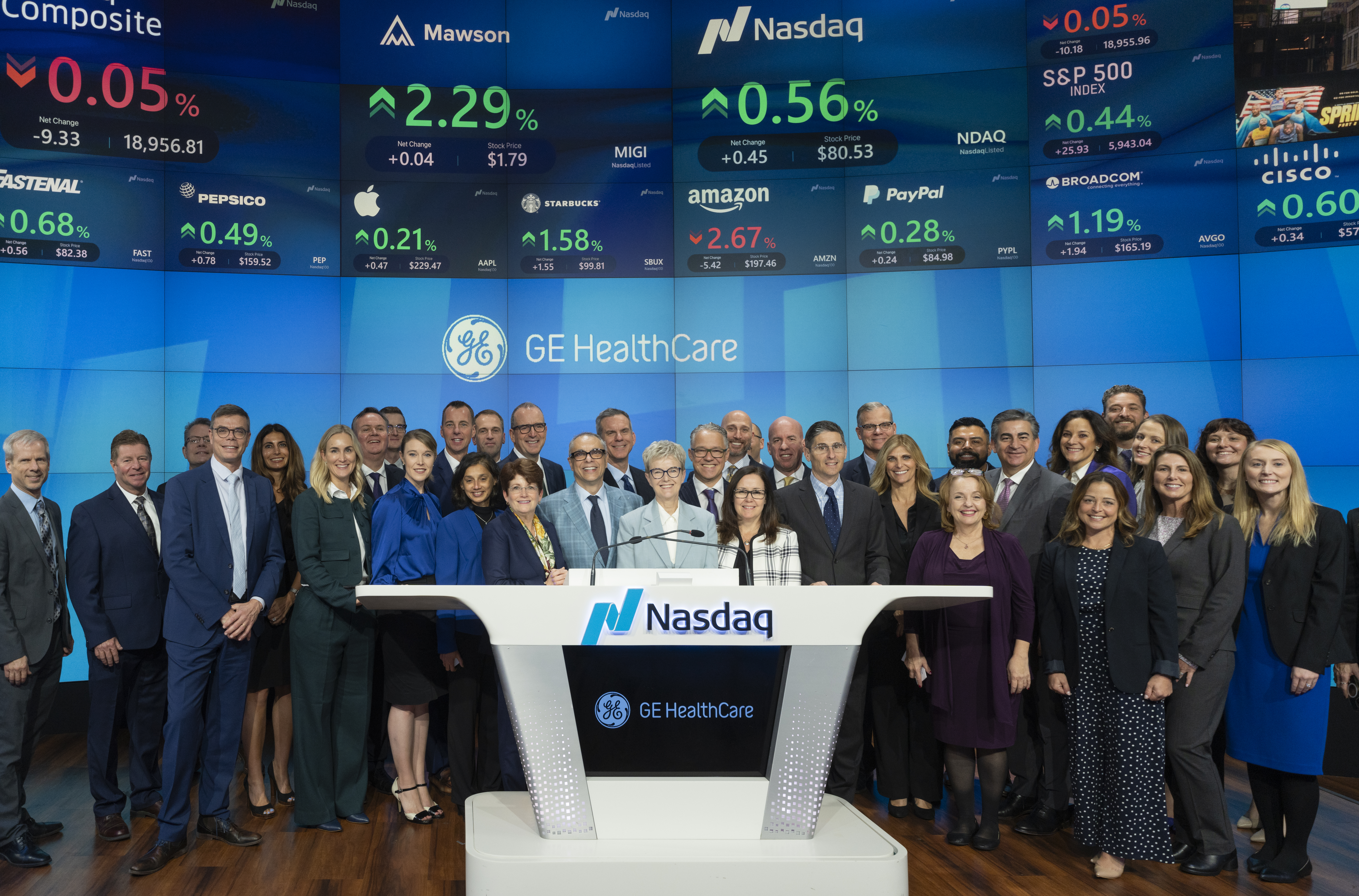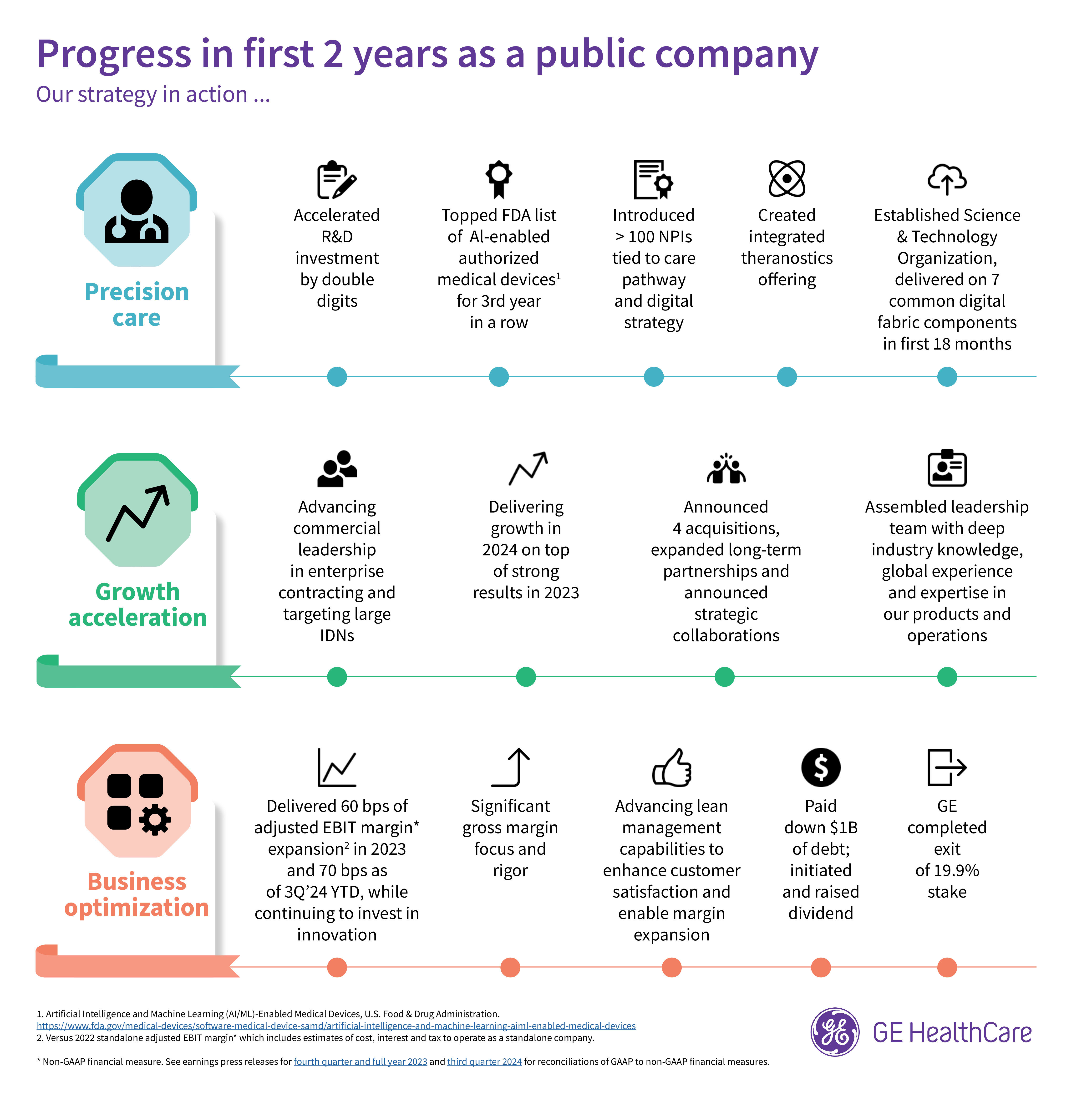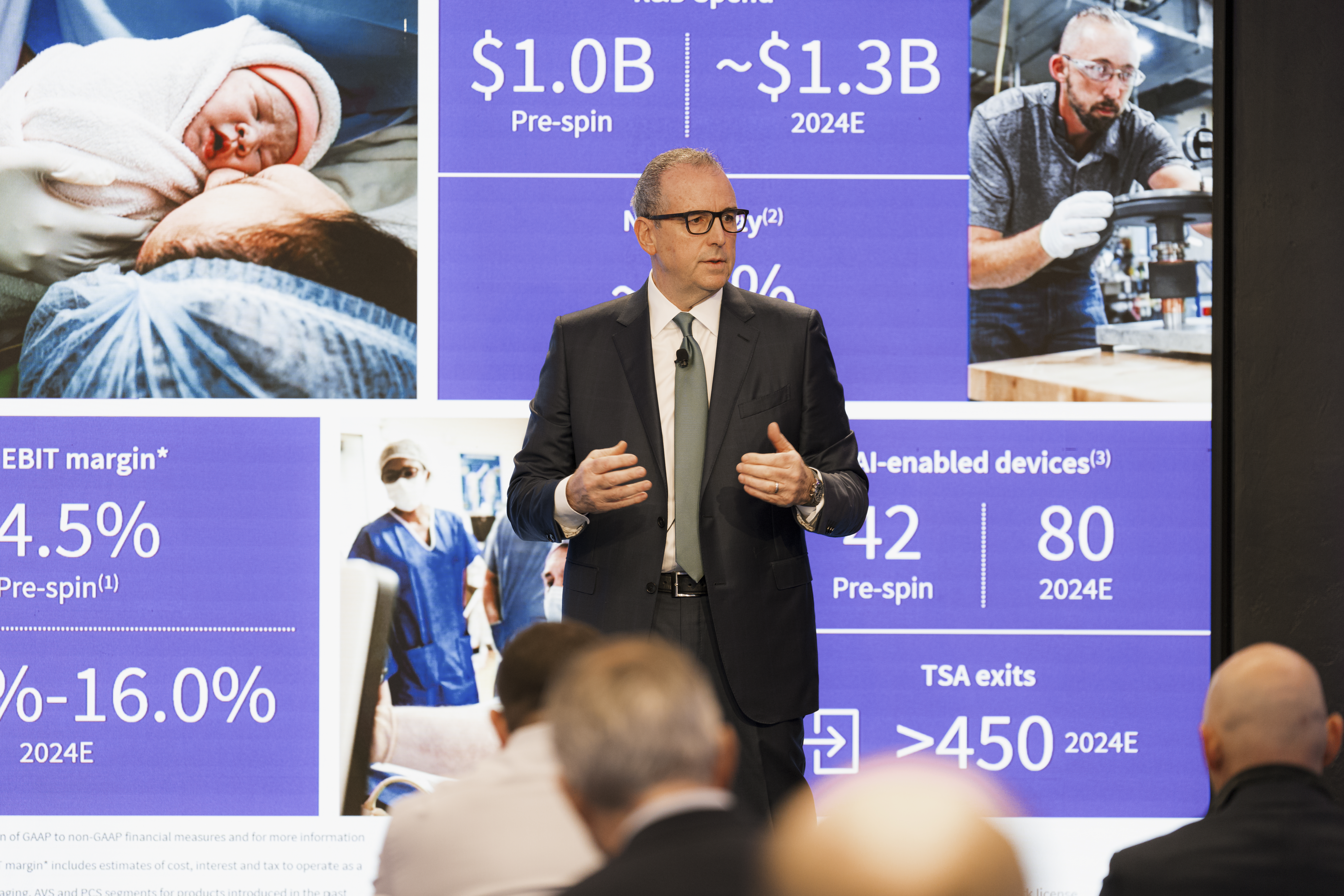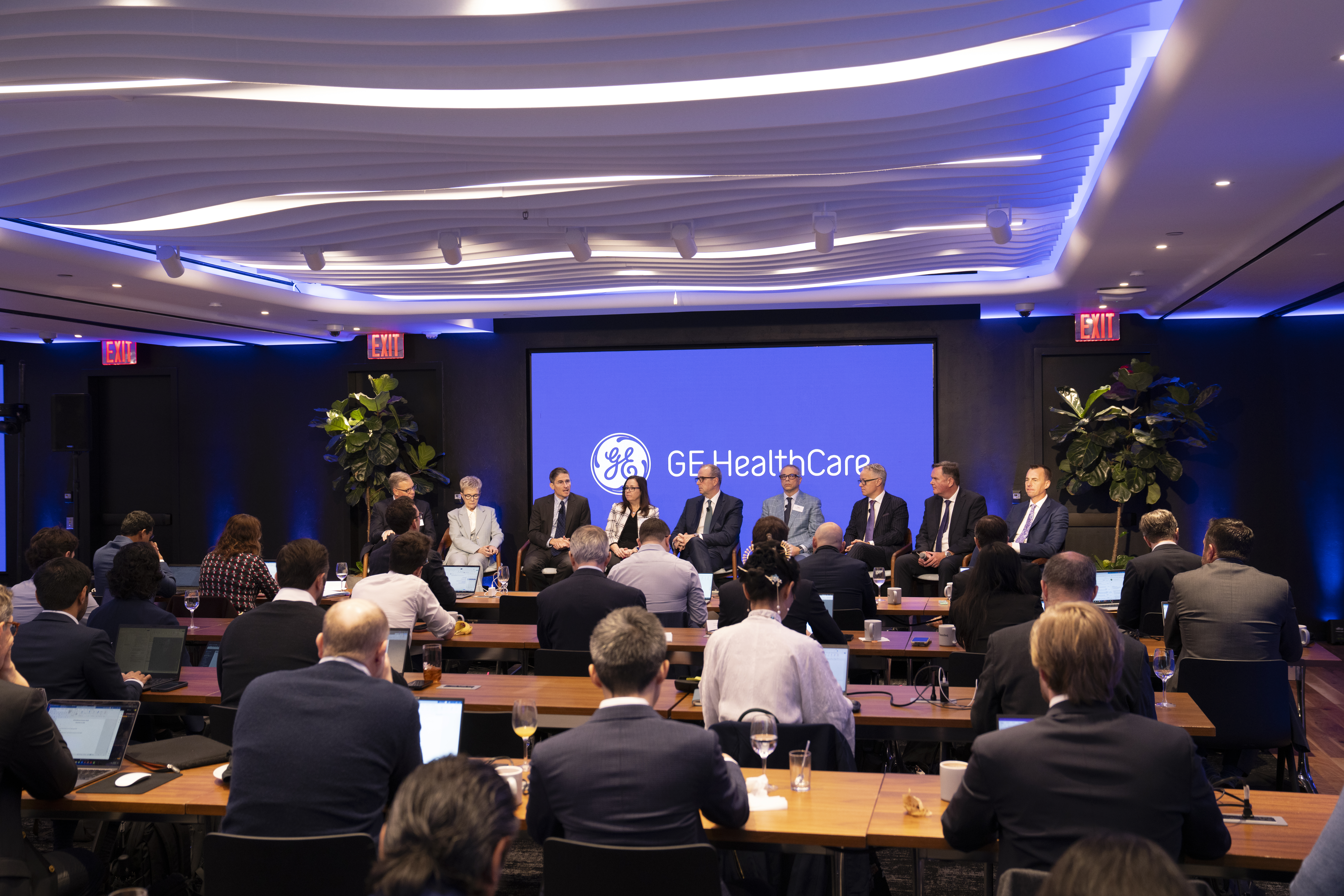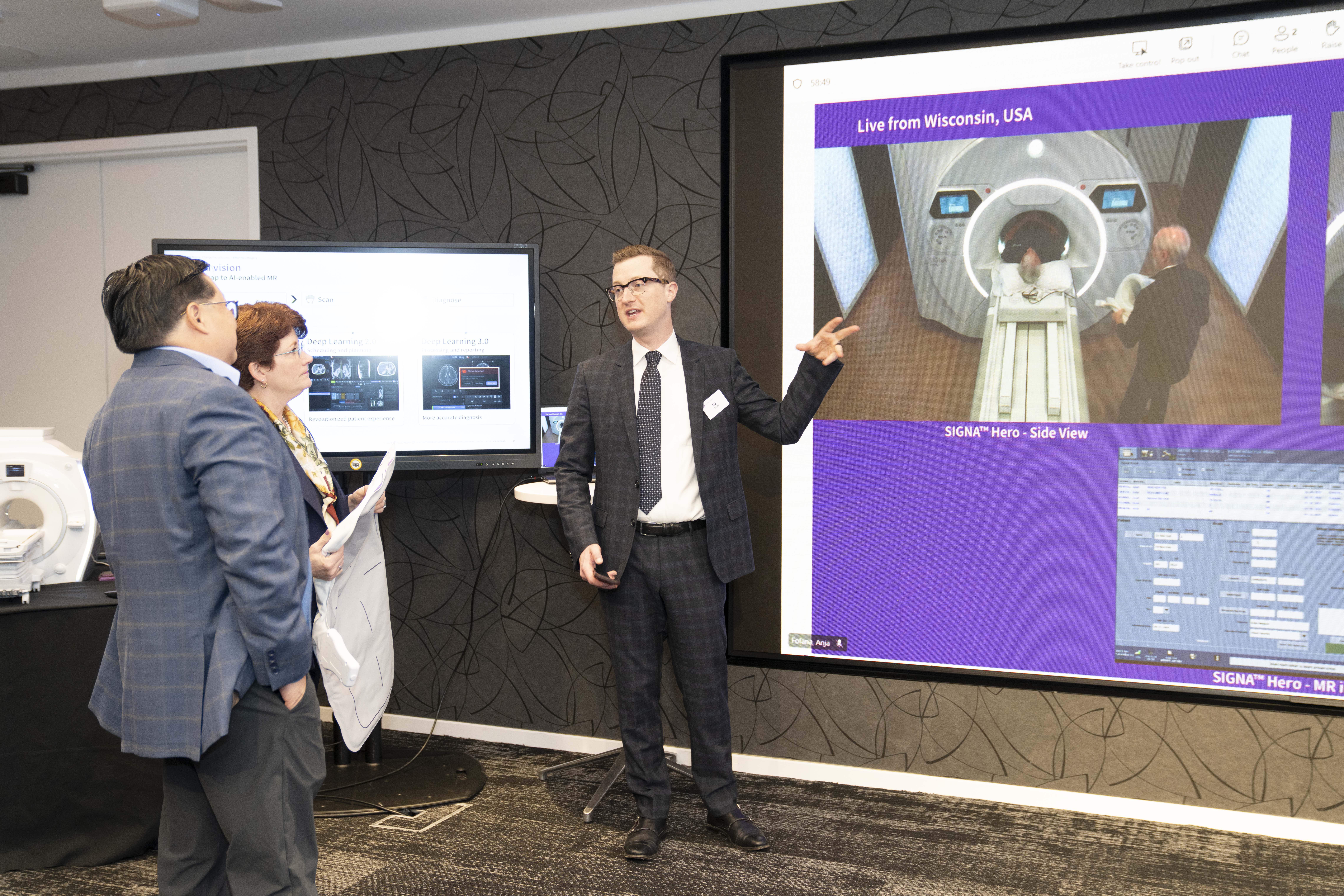Since spinning off from GE in January 2023, GE HealthCare has evolved into a comprehensive healthcare solutions provider that’s helping to build a healthier, more equitable world. It’s leveraging cutting-edge technology and making strategic investments to continue pushing a 125-year legacy of innovation into the future. In two years, its revenue has continued to grow, and the company has invested approximately $2.2 billion since 2022 back into the business to deliver its robust innovation pipeline.
Peter J. Arduini, president and CEO, and Jay Saccaro, vice president and CFO, were joined Nov. 21 by members of their executive leadership team to highlight that growth — and GE HealthCare’s strategic vision — while kicking off the company’s first Investor Day as an independent company at Nasdaq in New York City. Leaders explained to investors and analysts how GE HealthCare intends to grow organic revenue[1] by mid-single digits over the medium term (2026-2028). Their plan focused on three main areas. The first was continued investment in innovation, especially artificial intelligence (AI) and digital solutions, including the development of advanced imaging technologies, AI-powered diagnostic tools and remote monitoring solutions. Second is developing new products and technologies to address unmet clinical needs, through investments in research and development, strategic partnerships, and acquisitions. And the last piece is expanding the company’s global reach, particularly in emerging markets, where there is significant growth potential for medical devices.
1. Artificial Intelligence and Machine Learning (AI/ML)-Enabled Medical Devices, U.S. Food & Drug Administration. https://www.fda.gov/medical-devices/software-medical-device-samd/artificial-intelligence-and-machine-learning-aiml-enabled-medical-devices
2. Versus 2022 standalone adjusted EBIT margin* which includes estimates of cost, interest and tax to operate as a standalone company.
* Non-GAAP financial measure. See earnings press releases for fourth-quarter and full-year 2023 and third quarter 2024 for reconciliations of GAAP to non- GAAP financial measures.
“We are confident in our progress since spin and our path to accelerate growth driven by an exciting innovation pipeline. We look forward to continuing to execute on our growth strategy to help clinicians provide more precise, personalized care for patients, delivering on our purpose to create a world where healthcare has no limits,” said Arduini.
Core to the company’s success is its digital strategy, or D3 framework, to help deliver precision care. Arduini explained how this framework emphasizes the use of smart devices and drugs across disease states to bring data together in the right place at the right time. It already is beginning to differentiate the company from its competitors by offering providers holistic solutions to address key customer challenges like provider burnout, patient backlog and operational inefficiencies.
Arduini and the team demonstrated how D3 is embedded across the organization and critical to helping the company achieve mid-single-digit growth over the medium term. He said GE HealthCare will continue to stretch beyond its legacy of advanced imaging, deploying D3 in key growth areas such as theranostics, cardiology, neurology, oncology and molecular imaging.
Visionary innovation
GE HealthCare has invested approximately $2.2 billion since 2022 in research and development to create a pipeline of innovation that includes cloud based applications, enhancements to its product portfolio and new, AI-enabled solutions to address healthcare challenges. The company’s long history of innovation remains the foundation of each successive new product introduction, including a leading interventional system in its image-guided system (IGS) portfolio and an AI-enabled, handheld ultrasound. Over the next several years, GE HealthCare expects to deliver a host of new, next-gen leadership products, such as a photon-counting CT* — one of the most significant technological advancements in CT in decades — for use in multiple care areas.
Other future innovations include next-generation perinatal monitoring* that aims to improve maternal-fetal well-being with innovative partnerships and digital technology, including flexible devices and inventive sensors for real-time visualization and clinical decision support enabled by AI and machine learning. A full-body positron emission tomography (PET) system* based on GE HealthCare’s fastest-ever-selling PET/CT machines improves operational efficiency, enhances the patient experience and increases diagnostic power, with the goal of helping clinicians improve patient outcomes. And a scalable, performance-focused PET/CT is designed to evolve and help meet growing healthcare system demands, including striking image quality in oncology; an ability to accommodate increasing PET amyloid imaging volume related to Alzheimer’s diagnosis in neurology; and impressive imaging of a variety of cardiac tracers, including fast-decay tracers and new tracers in cardiology.
“Imaging is a cornerstone of effective healthcare, enabling precise diagnosis, guiding treatments, and helping clinicians improve patient outcomes across care areas. Based on the growth of chronic diseases and a growing and aging population, global demand for imaging procedures has grown steadily in recent years and is expected to continue to grow at a 4%-5% annual rate[2],” said Roland Rott, president and CEO of Imaging. “To meet the growing demand and maximize customer value, significant investments are being made to drive innovation, resulting more than 25 new product innovations targeted to launch through 2028 that will help clinicians stay at the forefront of precision care.”
As Phil Rackliffe, president and CEO of Advanced Visualization Solutions (AVS), explained, the realignment of the company’s Image-Guided Therapies and Ultrasound businesses in July 2024 aims to better serve customers who want to work with companies that provide a complete solution to help them solve challenges while performing minimally invasive procedures.
The AVS segment offers a host of innovative technologies that work together to assist clinicians in a variety of use cases. For example, the electrophysiology (EP) lab plays a pivotal role in the treatment of cardiac arrhythmias like A-fib. GE HealthCare’s Allia Pulse and specialized ultrasound technologies such as Vscan Air SL can work in conjunction inside an EP suite to create a better experience for customers and patients.
“We recently brought these two businesses together to create a new segment to better serve our customers. Now we are able to offer holistic and fully integrated solutions,” explained Rackliffe. “Our AVS portfolio positions us for seamless integration in environments like the interventional cath lab, where we will continue to drive clinically relevant innovation to expand and pursue commercial innovation to meet customer demands.”
GE HealthCare’s problem-solving mindset — taking customers’ greatest challenges and working backward from there — coupled with its world-class services and sales teams, helped the company secure long-term partnerships with hospitals, health systems and academic and research institutions, including working with the University of Essen Medicine in Germany to create a new Theranostics Center of Excellence and with the Mayo Clinic to advance innovation in medical imaging and theranostics.
As Catherine Estrampes, president and CEO of U.S. and Canada, explained to investors, “Our success with long-term enterprise partnerships comes down to our unique positioning with a holistic portfolio grounded in our D3 strategy that addresses our customers’ needs, and a stickiness that comes with this different kind of relationship allowing us to move from selling into serving.”
Radiopharmaceuticals enabling precision care across disease states
GE HealthCare’s proprietary diagnostic pharmaceuticals, along with hardware, software, and AI and digital solutions, uniquely positions the company to support a variety of disease states. As the only company with imaging equipment and pharmaceutical diagnostics, GE HealthCare is transforming radiopharmaceuticals — a booming market that is expected to grow significantly in the coming years — and helping to shape the future of molecular imaging.
The molecular imaging market is in the middle of a significant transformation, driven in part by the growing field of theranostics, which enables clinicians to treat what they see and see what they treat. In response, GE HealthCare is developing novel radiotracers and diagnostic radiopharmaceuticals that can help address unmet patient needs across oncology, cardiology and neurology. When used in conjunction with PET imaging, radiopharmaceuticals have the potential to help clinicians diagnose earlier, monitor disease progression and provide effective treatment in areas like Alzheimer’s disease, breast cancer and coronary artery disease.
In addition, the company is a leader in imaging agents like iodinated contrast media, which is expected to see global demand double over the next decade[3] due to increased demand for imaging procedures. GE HealthCare’s proprietary radiotracers and imaging agents are used to support over 120 million patient procedures per year globally, equivalent to four patient procedures every second.
GE HealthCare’s world-class Imaging and Pharmaceutical Diagnostics portfolios makes it the only company with a full suite of solutions to address provider and patient needs from drug discovery to disease screening and diagnostics to therapy.
The next era of GE HealthCare
GE HealthCare, which currently tops the U.S. Food and Drug Administration’s list of AI-enabled device authorizations,[4] intends to greatly accelerate growth in this space — going from its leading 80 authorizations over the past decade to an expected 200-plus in the next three years. The company expects to capitalize on recurring revenue opportunities by tripling its cloud-based solutions, powered by the latest advancements in AI, and grow digital revenue by around 50% by enabling a subscription-based model to drive consistent revenue.
Truly unlocking the potential of AI in healthcare means tackling two problems: the data deluge healthcare customers face daily and widespread operational inefficiencies within health systems. In response, the next era of GE HealthCare will be defined by its D3 strategy, which aims to leverage AI and digital solutions to embed AI in every device over the next eight years. Digital solutions will be tailored to each patient across their care journey, and advanced AI and predictive analytics will be used to reduce the cognitive burden on providers and make hospital operations more efficient.
The company is actively integrating AI into all its devices through increased R&D investments across the business. An example is Sonic DL, an application powered by deep learning that cuts cardiac MR imaging time by up to 83%. Its faster scan times enable clinicians to capture images within a single heartbeat, expanding care for patients who otherwise may not have had access to such technology.
GE HealthCare is also developing cloud-based digital solutions to enhance care for moms and babies by partnering with clinicians to create the next generation of mom and baby monitoring in labor and delivery. Tom Westrick, president and CEO of Patient Care Solutions, shared that GE HealthCare is exploring how to transform care delivery using AI-powered fetal heart rate algorithms, advancing generative AI to help clinicians minimize the effort spent searching through data, and harnessing multimodal data to help inform care decisions.
Looking to unlock the potential of AI across the enterprise, Chief Science and Technology Officer Dr. Taha Kass-Hout shared the company’s vision to take care to the next level with CareIntellect, a cloud-based offering of generative AI-powered clinical and operational applications. It streamlines patient data from multiple systems into a single view to help optimize care delivery and quality across disease states.
“With CareIntellect we hope to make it easier to infuse AI in healthcare — as simple as adding an app on your smartphone,” said Dr. Kass-Hout. He shared how early evaluations with customers using the first clinical application — CareIntellect for Oncology — are showing great promise in helping clinicians make quick, informed decisions. Hear from the Tampa General Hospital, which is using CareIntellect for Oncology in prostate and breast cancer treatment.
Dr. Kass-Hout also highlighted one of the company’s research projects, Project Health Companion,[5] which could become part of the CareIntellect ecosystem. The Health Companion project aims to put multidisciplinary problem-solving at clinicians’ fingertips using agentic AI to analyze multimodal data and generate treatment plan recommendations.
“We are transforming healthcare, delivering precision care through innovation by building AI and digital solutions to enhance devices, transform the care journey across disease states, and vastly improve operational efficiency,” said Kass-Hout. “We have the expertise, the track record and the vision to build the next generation of innovation to drive the healthcare industry forward.
Advancing the healthcare industry
As GE HealthCare enters its third year as a standalone company, its leaders are confident in its progress and strategic vision, noting that it is well situated to innovate, drive growth and create long-term value for patients, customers and shareholders. As they shared at Investor Day 2024, they look forward to continuing to deliver innovative technologies that allow clinicians to provide more precise, personalized care for patients globally and, ultimately, to create a world where healthcare has no limits.
“We’ve generated significant momentum since spin, and we are well positioned to continue on this trajectory. Led by our highly talented leadership team, we are focused on delivering on our precision care strategy, accelerating growth, and further optimizing our business while creating value for our customers, patients and providers,” said Arduini.
*Technology in development that represents ongoing research and development efforts. These technologies are not products and might never become products. Not for sale. Not cleared or approved by the U.S. FDA or any other global regulator for commercial availability. This is neither an offer nor an agreement to supply the technologies. Cannot be placed on the market or put into service until it has been made to comply with the Medical Device Regulation requirements for CE marking.
[1] Non-GAAP financial measure.
[2] GE HealthCare estimated global end markets as of December 2023 – excludes IGT, and estimated market CAGR 2024–2028
[3] GE HealthCare internal market projections.
[4] Artificial Intelligence and Machine Leaning (AI/ML)-Enabled Medical Devices, U.S. Food & Drug Administration.
[5] Concept only. This work is in concept phase and might never become a product. Not for sale. Not cleared or approved by the U.S. FDA or any other global regulator for commercial availability. This is neither an offer nor an agreement to supply the technologies. Cannot be placed on the market or put into service until it has been made to comply with the Medical Device Regulation requirements for CE marking.

